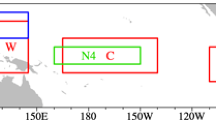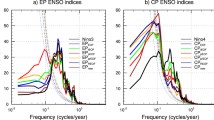Abstract
This study reinspects the dominant modes of different types of El Niño from the perspectives of monthly mean and seasonality using a combined technique referred as RC-REOF. Several features have been revealed. (1) The explained variances of eastern Pacific (EP) El Niño and central Pacific (CP) El Niño are comparable, in the ranges of 33–43 and 23–28 %, respectively. (2) This feature is more in line with the frequent occurrence of CP El Niño compared to the result from orthogonal EOF analysis in which El Niño Modoki explains a smaller variance of 11–12 %. (3) Both special patterns of EP El Niño and CP El Niño are of equatorial asymmetry that is often overlooked previously by the traditional Niño indices. Based on the features captured by the two leading RC-REOF modes, the authors propose a new pair of Niño indices referred to as Niño3b and Niño4b that have the following advantages: (1) simple calculation, (2) robust and stable relationship with the EP/CP El Niño modes, (3) more representative for Pacific decadal signals, (4) easier to distinguish ENSO types, and (5) without restriction by orthogonality, and others. The Niño3b and Niño4b indices are potentially useful for both scientific research and real-time monitoring of the two types of El Niño. Besides, an index namely Niño3.4b is also introduced to describe the hybrid ENSO events, with relatively equal covariance to EP El Niño and CP El Niño and with larger covariance at decadal time scale than index Niño3.4.















Similar content being viewed by others
Explore related subjects
Discover the latest articles and news from researchers in related subjects, suggested using machine learning.References
Ashok K, Behera SK, Rao SA, Weng H, Yamagata T (2007) El Niño Modoki and its possible teleconnection. J Geophys Res 112:C11007. doi:10.1029/2006JC003798
Cai W et al (2014) Increasing frequency of extreme El Niño events due to greenhouse warming. Nat Clim Change 4:111–116. doi:10.1038/nclimate2100
Cai W et al (2015a) ENSO and greenhouse warming. Nat Clim Change 5:849–859. doi:10.1038/nclimate2743
Cai W et al (2015b) Increased frequency of extreme La Niña events under greenhouse warming. Nat Clim Change 5:132–137. doi:10.1038/nclimate2492
Capotondi A et al (2015) Understanding ENSO diversity. Bull Am Meteorol Soc 96:921–938. doi:10.1175/BAMS-D-13-00117.1
Feng J, Li J (2011) Influence of El Niño Modoki on spring rainfall over South China. J Geophys Res 116:D13102. doi:10.1029/2010JD015160
Feng J, Li J (2013) Contrasting impacts of two types of ENSO on the boreal spring Hadley circulation. J Clim 26:4773–4789. doi:10.1175/JCLI-D-12-00298.1
Fu C, Fletcher JO (1985) Two types of equatorial warming during El Niño. Chin Sci Bull 8:596–599 (in Chinese)
Fu C, Diaz HF, Fletcher JO (1986) Characteristics of the response of sea surface temperature in the central Pacific associated with warm episodes of the Southern Oscillation. Mon Weather Rev 114:1716–1739
Graf H-F (1986) On El Niño/Southern Oscillation and Northern Hemispheric temperature. Gerlands Beitr Geophys 95:63–75
Graf H-F, Zanchettin D (2012) Central Pacific El Niño, the “subtropical bridge”, and Eurasian climate. J Geophys Res 117(D1):D01102. doi:10.1029/2011JD016493
Graham NE, Barnett TP (1987) Sea surface temperature, surface wind divergence, and convection over tropical oceans. Science 238:657–659. doi:10.1126/science.238.4827.657
Ha Y, Zhong Z, Yang X, Sun Y (2013) Different Pacific Ocean warming decaying types and Northwest Pacific tropical cyclone activity. J Clim 26:8979–8994. doi:10.1175/JCLI-D-13-00097.1
Henley BJ, Gergis J, Karoly DJ, Power S, Kennedy J, Folland CK (2015) A tripole index for the Interdecadal Pacific Oscillation. Clim Dyn 45:3077–3090. doi:10.1007/s00382-015-2525-1
Horel JD (1981) A rotated principal component analysis of the interannual variability of the Northern Hemisphere 500-mb height field. Mon Weather Rev 109:2080–2092
Hu C, Yang S, Wu Q (2015) An optimal index for measuring the effect of East Asian winter monsoon on China winter temperature. Clim Dyn 45:2571–2589. doi:10.1007/s00382-015-2493-5
Huang B, Banzon VF, Freeman E, Lawrimore J, Liu W, Peterson TC, Smith TM, Thorne PW, Woodruff SD, Zhang H-M (2015) Extended reconstructed sea surface temperature version 4 (ERSST.v4). Part I: upgrades and intercomparisons. J Clim 28:911–930. doi:10.1175/JCLI-D-14-00006.1
Iza M, Calvo N (2015) Role of stratospheric sudden warmings on the response to central Pacific El Niño. Geophys Res Lett 42:2482–2489. doi:10.1002/2014GL062935
Jo H-S, Yeh S-W, Lee S-K (2015) Changes in the relationship in the SST variability between the tropical Pacific and the North Pacific across the 1998/1999 regime shift. Geophys Res Lett 42:7171–7178. doi:10.1002/2015GL065049
Kao H-Y, Yu J-Y (2009) Contrasting eastern-Pacific and central-Pacific types of ENSO. J Clim 22:615–632. doi:10.1175/2008JCLI2309.1
Karori MA, Li J, Jin F-F (2013) The asymmetric influence of the two types of El Niño and La Niña on summer rainfall over Southeast China. J Clim 26:4567–4582. doi:10.1175/JCLI-D-12-00324.1
Kim H-M, Webster PJ, Curry JA (2009) Impact of shifting patterns of Pacific Ocean warming on North Atlantic tropical cyclones. Science 325:77–80. doi:10.1126/science.1174062
Kug J-S, Jin F-F, An S-I (2009) Two types of El Niño events: cold tongue El Niño and warm pool El Niño. J Clim 22:1499–1515. doi:10.1175/2008JCLI2624.1
Larkin NK, Harrison DE (2005) On the definition of El Niño and associated seasonal average US weather anomalies. Geophys Res Lett 32:L13705
Latif M, Keenlyside NS (2009) El Niño/Southern Oscillation response to global warming. Proc Natl Acad Sci USA 106:20578–20583. doi:10.1073/pnas.0710860105
Lau K-M, Yang S (1996) The Asian monsoon and predictability of the tropical ocean-atmosphere system. Q J R Meteorol Soc 122:945–957
Lee T, McPhaden MJ (2010) Increasing intensity of El Niño in the central-equatorial Pacific. Geophys Res Lett 37:L14603
Li G, Ren B, Yang C, Zheng J (2010) Indices of El Niño and El Niño Modoki: an improved El Niño Modoki index. Adv Atmos Sci 27(5):1210–1220
Lian T, Chen D (2012) An evaluation of rotated EOF analysis and its application to tropical pacific SST variability. J Clim 25:5361–5373. doi:10.1175/JCLI-D-11-00663.1
Liu W, Huang B, Thorne PW, Banzon VF, Zhang H-M, Freeman E, Lawrimore J, Peterson TC, Smith TM, Woodruff SD (2015) Extended reconstructed sea surface temperature version 4 (ERSST.v4): part II. Parametric and structural uncertainty estimations. J Clim 28:931–951. doi:10.1175/JCLI-D-14-00007.1
López-Parages J, Rodríguez-Fonseca B, Dommenget D, Frauen C (2016) ENSO influence on the North Atlantic European climate: a non-linear and non-stationary approach. Clim Dyn. doi:10.1007/s00382-015-2951-0
Marathe S, Ashok K, Swapna P, Sabin TP (2015) Revisiting El Niño Modokis. Clim Dyn 45:3527–3545. doi:10.1007/s00382-015-2555-8
Nakamura H, Lin G, Yamagata T (1997) Decadal climate variability in the North Pacific during the recent decades. Bull Am Meteorol Soc 78:2215–2225
North GR, Bell TL, Cahalan RF, Moeng FJ (1982a) Sampling errors in the estimation of empirical orthogonal functions. Mon Weather Rev 110:699–706
North GR, Moeng FJ, Bell TL, Cahalan RF (1982b) The latitude dependence of the variance of zonally averaged quantities. Mon Weather Rev 110:319–326
Parker D et al (2007) Decadal to multidecadal variability and the climate change background. J Geophys Res 112:D18115
Power S, Casey T, Folland C, Colman A, Mehta V (1999) Inter-decadal modulation of the impact of ENSO on Australia. Clim Dyn 15(5):319–324
Rayner NA, Parker DE, Horton EB, Folland CK, Alexander LV, Rowell DP, Kent EC, Kaplan A (2003) Global analyses of sea surface temperature, sea ice, and night marine air temperature since the late nineteenth century. J Geophys Res 108(D14):4407. doi:10.1029/2002JD002670
Ren H-L, Jin F-F (2011) Niño indices for two types of ENSO. Geophys Res Lett 38:L04704. doi:10.1029/2010GL046031
Richman MB (1986) Rotation of principal components. Int J Climatol 6:293–335
Ropelewski CF, Jones PD (1987) An extension of the Tahiti–Darwin Southern Oscillation Index. Mon Weather Rev 115:2161–2165
Sardeshmukh PD, Hoskins BJ (1988) The generation of global rotational flow by steady idealized tropical divergence. J Atmos Sci 45:1228–1251
Sun J, Wu S, Ao J (2015) Role of the North Pacific sea surface temperature in the East Asian winter monsoon decadal variability. Clim Dyn. doi:10.1007/s00382-015-2805-9
Takahashi K, Montecinos A, Goubanova K, Dewitte B (2011) ENSO regimes: reinterpreting the canonical and Modoki El Niño. Geophys Res Lett 38:L10704. doi:10.1029/2011GL047364
Trenberth KE, Stepaniak DP (2001) Indices of El Niño evolution. J Clim 14:1697–1701
Vavrus S, Notaro M, Liu Z (2006) A mechanism for abrupt climate change associated with tropical Pacific SSTs. J Clim 19:242–256. doi:10.1175/JCLI3608.1
Wallace JM, Gutzler DS (1981) Teleconnections in the geopotential height field during the Northern Hemisphere winter. Mon Weather Rev 109:784–812
Wang L, Chen W, Huang R (2007) Changes in the variability of North Pacific Oscillation around 1975/1976 and its relationship with East Asian winter climate. J Geophys Res 112:D11110. doi:10.1029/2006JD008054
Wang L, Chen W, Huang R (2008) Interdecadal modulation of PDO on the impact of ENSO on the East Asian winter monsoon. Geophys Res Lett 35:L20702
Wang L, Chen W, Zhou W, Chan JCL, Barriopedro D, Huang R (2010) Effect of the climate shift around mid 1970s on the relationship between wintertime Ural blocking circulation and East Asian climate. Int J Climatol 30:153–158
Webster PJ (1995) The annual cycle and the predictability of the tropical coupled ocean–atmosphere system. Meteorol Atmos Phys 56:33–55
Webster PJ, Yang S (1992) Monsoon and ENSO: selectively interactive systems. Q J R Meteorol Soc 118:877–926
Weng H, Ashok K, Behera SK, Rao SA, Yamagata T (2007) Impacts of recent El Niño Modoki on dry/wet conditions in the Pacific rim during boreal summer. Clim Dyn 29:113–129. doi:10.1007/s00382-007-0234-0
Weng H, Behera SK, Yamagata T (2009) Anomalous winter climate conditions in the Pacific rim during recent El Niño Modoki and El Niño events. Clim Dyn 32:663–674. doi:10.1007/s00382-008-0394-6
Wolter K, Timlin MS (1998) Measuring the strength of ENSO events: How does 1997/98 rank? Weather 53:315–324
Xie F, Li J, Tian W, Feng J, Huo Y (2012) Signals of El Niño Modoki in the tropical tropopause layer and stratosphere. Atmos Chem Phys 12:5259–5273. doi:10.5194/acp-12-5259-2012
Xie F, Li J, Tian W, Li Y, Feng J (2014a) Indo-Pacific warm pool area expansion, Modoki activity, and tropical cold-point tropopause temperature variations. Sci Rep 4:4552. doi:10.1038/srep04552
Xie F, Li J, Tian W, Zhang J, Sun C (2014b) The relative impacts of El Niño Modoki, canonical El Niño, and QBO on tropical ozone changes since the 1980s. Environ Res Lett 9:064020. doi:10.1088/1748-9326/9/6/064020
Yeh S-W, Kug J-S, Dewitte B, Kwon M-H, Kirtman BP, Jin F-F (2009) El Niño in a changing climate. Nature 461:511–514. doi:10.1038/nature08316
Yu J-Y, Kao H-Y (2007) Decadal changes in ENSO persistence barrier in SST and ocean content indices: 1958–2001. J Geophys Res 112:D13106
Yu J-Y, Kim ST (2010) Identification of central-Pacific and eastern-Pacific types of ENSO in CMIP3 models. Geophys Res Lett 37:L15705
Yu J-Y, Kim ST (2011) Relationships between extratropical sea level pressure variations and the central Pacific and eastern Pacific types of ENSO. J Clim 24:708–720. doi:10.1175/2010JCLI3688.1
Yu J-Y, Kim ST (2013) Identifying the types of major El Niño events since 1870. Int J Climatol 33:2105–2112. doi:10.1002/joc.3575
Yu J-Y, Zou Y (2013) The enhanced drying effect of central-Pacific El Niño on US winter. Environ Res Lett 8:014019. doi:10.1088/1748-9326/8/1/014019
Yu J-Y, Kao H-Y, Lee T (2010) Subtropics-related interannual sea surface temperature variability in the central equatorial Pacific. J Clim 23:2869–2884. doi:10.1175/2010JCLI3171.1
Yu J-Y, Zou Y, Kim ST, Lee T (2012) The changing impact of El Niño on US winter temperatures. Geophys Res Lett 39:L15702. doi:10.1029/2012GL052483
Yuan Y, Yang S (2012) Impacts of different types of El Niño on the East Asian climate: focus on ENSO cycles. J Clim 25:7702–7777
Acknowledgments
The study was supported by the National Key Scientific Research Plan of China (Grants 2012CB956002 and 2014CB953900), the National Natural Science Foundation of China (Grants 41375076 and 41375081), the China Special Fund for Meteorological Research in the Public Interest (Grant 201206038), the LASW State Key Laboratory Special Fund (2013LASW-A05), and the Jiangsu Collaborative Innovation Center for Climate Change. Calculations for this study were supported by the China National Supercomputer Center in Guangzhou.
Author information
Authors and Affiliations
Corresponding author
Electronic supplementary material
Below is the link to the electronic supplementary material.
Rights and permissions
About this article
Cite this article
Hu, C., Yang, S., Wu, Q. et al. Reinspecting two types of El Niño: a new pair of Niño indices for improving real-time ENSO monitoring. Clim Dyn 47, 4031–4049 (2016). https://doi.org/10.1007/s00382-016-3059-x
Received:
Accepted:
Published:
Issue Date:
DOI: https://doi.org/10.1007/s00382-016-3059-x




